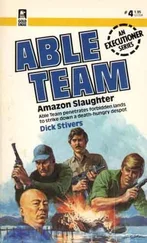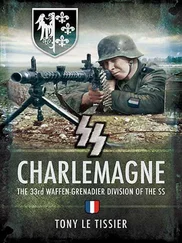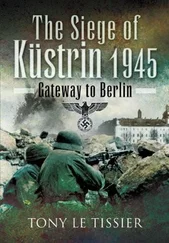Within the pocket communications continued to deteriorate. One German soldier noted that day: ‘The rumour is going around that we are breaking out.’ [8] Lakowski/Stich, Der Kessel von Halbe 1945 , p. 97.
In fact attempts were made to break out at several points of the encirclement, but there is no evidence as to who planned or ordered them. From the Soviet point of view, these were seen as important attempts to force a breakthrough by means of waves of attacks, but could in fact have been the efforts of individual units acting on their own initiative, or simply local counterattacks.
Marshal Koniev commented:
The stronger the pressure was exerted against them and the harder the blows they received from behind, the more vigorously they tried to break through to our rear. Each thrust from behind seemed to pass through them to us, in front. The enemy concentrated their battle formations and attacked us more and more actively. This was only to be expected, for there was no alternative but surrender. [9] Koniev, Year of Victory , p. 180.
The pressure on the northern, eastern and southern parts of the perimeter were hard for 9th Army to take. Nowhere was it able to stop the advance of the overwhelming Soviet forces, the German troops having to give up more and more territory and villages.
The Gross Köris sector could no more be held than the gaps between the lakes near Prieros, Storkow and Wendisch Rietz, where the positions of 32nd SS Division and Panzergrenadier Division Kurmark had to be abandoned, their lines of retreat being strewn with vehicles, either shot-up or destroyed because of lack of fuel, and heavy weapons blown up for lack of towing vehicles or ammunition. SS-Captain Paul Krauss described the scene:
It was now just a matter of getting out of the ever-narrowing pocket to the west intact. More and more motor vehicles mixed with the horse-drawn carts of the refugees in column after column winding their way through the forest tracks to Halbe, where the break-out was to take place. All the time there were enemy ground-attack aircraft overhead shooting at the throngs of people and vehicles, causing casualty after casualty. Bodies were flying through the air; here and there vehicles were beginning to burn and falling apart; ammunition trucks were exploding. Chaos had begun and everyone pressed in from behind, no one wanting to leave the column or lose contact.
It was not until late afternoon on 27 April that the stream of vehicles ceased with only the odd column coming up behind. It appeared that the main body had reached Halbe. [10] Spaether, Die Geschichte des Panzerkorps ‘Großdeutschland’ , pp. 637–8.
On the southern edge of the encirclement near Märkisch Buchholz, one of the important traffic junctions, fierce fighting took place, the village itself changing hands several times that day. Soviet armour finally reached the line Kuschkow–Schlepzig–Halbe–Löpten, and both Teupitz and Halbe were re-occupied by Soviet infantry, thus blocking off the whole break-out sector. [11] Kortenhaus, Der Einsatz der 21. Panzer-Division , p. 140.
During the course of the day the size of the pocket was not only considerably reduced, it was also split as a result of a thrust by troops of 1st Byelorussian Front’s 3rd Army from the Gräbendorf area west of Prieros as far as Gross Köris and Prieros, a move that the remains of 32nd SS Division and its tank-hunting battalion were unable to prevent. SS-Captain Krauss wrote of this many years later:
The 9th Army in the area south of Berlin was already in a big pocket that had become split into several small ones at Müllrose, Prieros and elsewhere. The Prieros pocket was about 21 kilometres across. In it were about 10,000–14,000 German soldiers of all arms of service and also about 20,000 civilians with their herds of cattle, individual animals, household articles; there were families, women with children, some on foot, some with horse-drawn carts, handcarts. All this under continuous artillery and mortar fire and air attack from the Russians, which could not fail to hit something each time. Conditions in the pocket were horrendous. Soldiers, civilians, children, women and vehicles moved round in a circle, trying to avoid the fire like a giant, thousand-legged worm biting itself in the tail. Officers, soldiers, civilians with their families, whole groups of German people were shooting themselves. I looked across at this spectacle shattered, stunned and helpless. [12] Lakowski/Stich, Der Kessel von Halbe 1945 , pp. 104–5, citing Krauß Report, 1997.
Apart from Krauss’ report, little of this particular pocket is known, nor is anything to be found about it among Soviet sources.
However, the Army and Waffen-SS units taking the brunt of the fighting on the northern and eastern sectors of the perimeter had had enough, and at 1400 hours that day their commanders convened at the command post of XI SS Panzer Corps, which was located at the Birkbusch forest warden’s lodge, and told SS-General Mathias Kleinheisterkamp that, if he did not conduct an immediate break-out on his own initiative, they would do so themselves. (If this was the attitude of subordinate formation commanders, then confidence in General Busse and his headquarters was clearly lacking.) A break-out was then agreed for early next morning, providing the combat teams of 32nd SS Division could first disengage on the eastern sector of the perimeter along the line Eichholz forest warden’s lodge–Kehrigk–Bugk. As a preliminary measure, SS-Colonel Hans Kempin resumed command of the combat teams of V SS Mountain Corps that had meantime been detached to various commands over the past few days while securing this part of the perimeter. [13] Wilke, Am Rande der Strassen , pp. 123–4.
Meanwhile 9th Army reported by radio to Army Group Weichsel as follows:
V Corps : enemy penetrations near Märkisch Buchholz forced back. Enemy in Teupitz and Teurow. The redeployment of V SS Mountain Corps on the line Hartmannsdorf [near Lübben] Dürrenhofe–Kuschkow– Pretschen–Plattkow–Ahrensdorf–southern edge Scharmützelsee strongly pressed by the enemy.
XI SS Panzer Corps : breach between Gross Schauener See and Langer See.
The seriousness of the situation is reflected in this signal from Army Group Weichsel to 12th Army: ‘9th Army’s attacking spearheads at Mückendorf (NE of Baruth). Strong counterattacks. Help from the west urgently desired.’ [14] Lakowski/Stich, Der Kessel von Halbe 1945 , pp. 97–8.
This was a request that 12th Army was no longer in a position to meet. Wenck’s troops were fully engaged all along the whole line of advance. The 9th Army would have to make its own way. [15] Wenck, ‘Berlin war nicht mehr zu retten’, p. 66.
The 1st Scharnhorst Grenadier Regiment took Reesdorf and was then ordered to stop and consolidate there, while the 3rd Scharnhorst on the right flank reached and held the line Schlalach–Brachwitz–Buchholz, dug in and repelled Soviet counterattacks. The Scharnhorst Infantry Division was supported in these operations by the 1170th SPG Brigade, which suffered heavy casualties in the process. [16] Gellermann, Die Armee Wenck , p. 84.
Wenck’s attack had thus isolated 6th Guards Mechanized Corps from the rest of 4th Guards Tank Army at a time when this corps was extended over a distance of some 28 kilometres. The 5th Guards Mechanized Corps and 13th Army were having to form a double front, expecting Busse’s 9th Army to try and break out to the west at any moment from behind them, while the rest of 4th Guards Tank Army was still heavily engaged in the containment of the Potsdam and Wannsee ‘islands’. [17] Tieke, Das Ende zwischen Oder und Elbe , p. 238.
Читать дальше












